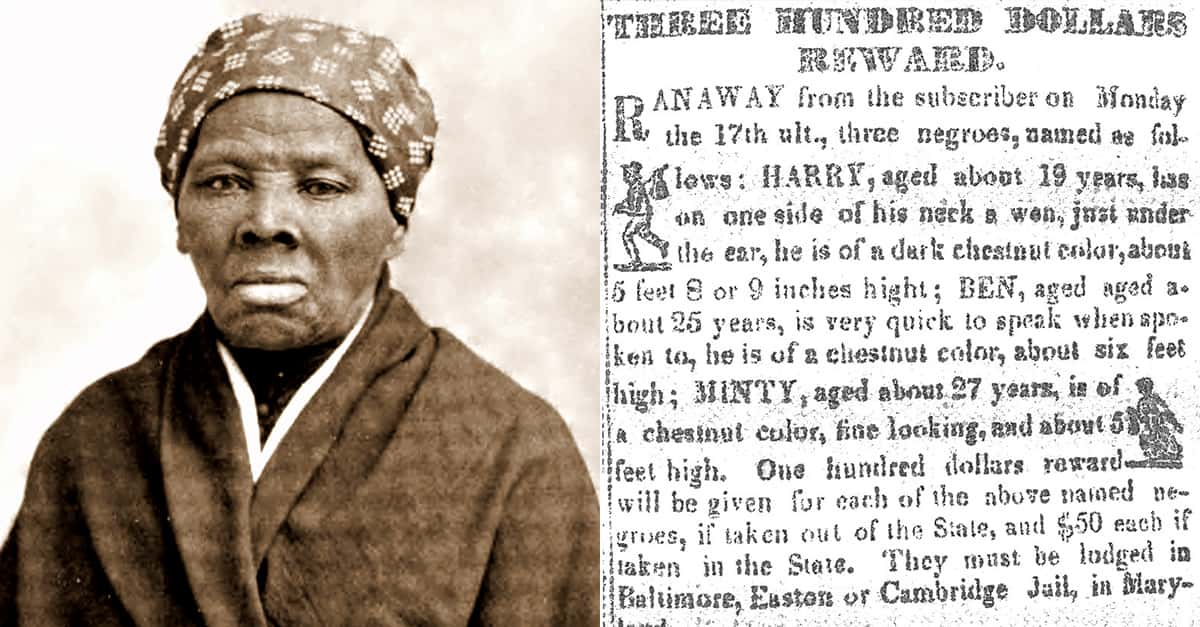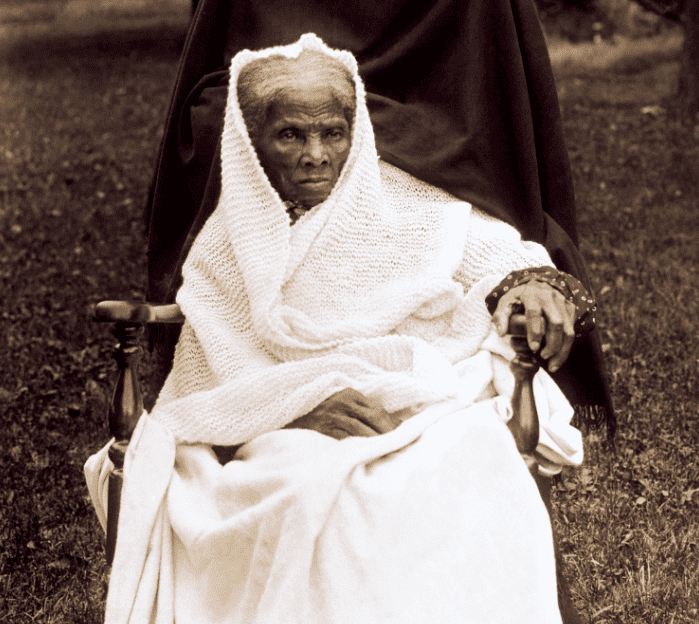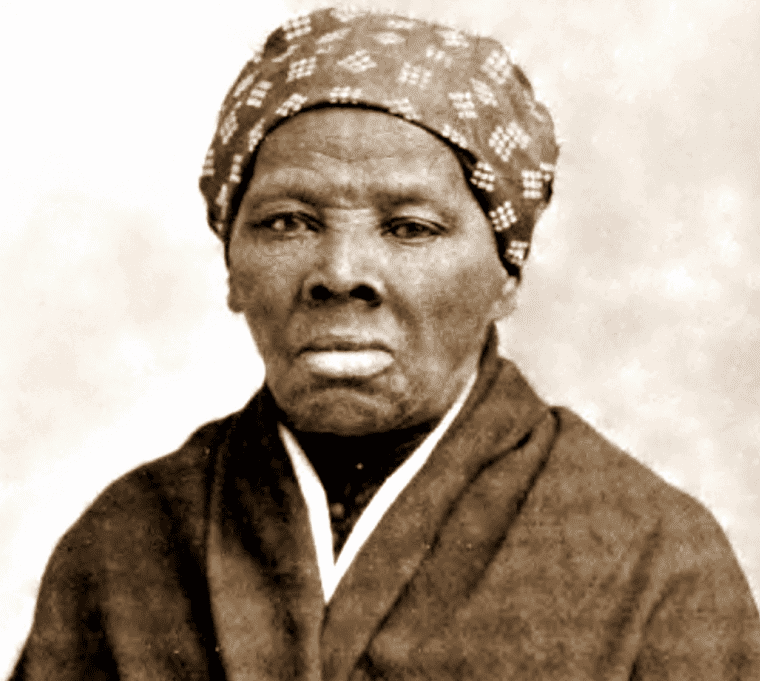The people called her Moses. Much like the Old Testament patriarch, she guided an oppressed people towards liberation. The mysterious spells she suffered, replete with visions, brought a sense of spiritual urgency to her work, and only added to the belief that Tubman was on a mission from God. Tubman spent her whole life—nearly 100 years—working to improve the lives of society’s most marginalized people. She freed thousands, she said, “but could have freed a thousand more, if they only knew they were slaves". Here are 42 liberating facts about Harriet Tubman.
1. Born in Captivity
Harriet Tubman was born into slavery sometime between 1815 and 1825. Her parents, Harriet Green and Ben Ross, were slaves at Edward Brodess’s plantation in Dorchester County, Maryland. Tubman grew up on the Brodess plantation, even as her family was gradually sold to other plantations and broken up.

2. Staying Together for the Kids
Tubman’s mother did her best to keep the family together. When one Georgia slaveowner bought her youngest son, Moses, Harriet Green threatened to split the man’s head open with an ax. The slaveowner could tell she was serious and relented. This instance of successful resistance was to have a profound effect on the young Tubman.
3. Hidden Roots
It would be impossible to trace Tubman’s precise lineage under such circumstances. We do know that Tubman’s maternal grandmother was taken from Africa to America. There have been some suggestions that Tubman’s ancestors may have been members of the Ashanti tribe of what is now Ghana.
4. Minty Fresh
Harriet Tubman was not her name at birth. She was, in fact, born Araminta Ross; her friends and family mostly called her Minty. She adopted the name Harriet as a teenager as a way of honoring her mother. She took the name Tubman when she married her first husband, John Tubman.
5. Work Clothes
Tubman was frequently rented to out to other homes to serve as a maid, nursemaid, and field hand. Tubman was bad at most of these chores, a fact compounded by her own resistance to performing slave labor, and was frequently beaten. Tubman claims she was once whipped five times before breakfast had been served. She found an effective way to soften these beatings, however, by wearing several layers of clothing at once.
6. Talking to God
As a teenager, Tubman was struck on the head when an overseer threw an iron weight. She was knocked unconscious, and though she came to a short time later, she would struggle for the rest of her life with seizures and narcolepsy. Tubman claimed to receive visions and messages from God during these spells.
7. Terms and Conditions
Under a contract, Ben Ross was released from slavery at the age of 45. The terms of the contract were to extend to his wife and children, as well—all would be freed when they reached the age of 45. The Brodess family chose to ignore these terms of the contract, however. With the law against him, and no money to buy their freedom, Ben Ross was powerless to help his family.
8. Opposites Attract
In 1844, the erstwhile Harriet Ross married John Tubman. The Tubman’s marriage was complicated: John Tubman was free, while Harriet Tubman was still a slave. This was not an uncommon situation in a state like Maryland, which sat between the north and the south.
9. Separate Ways
When Harriet Tubman finally fled to freedom in 1849, escaping to the free state of Pennsylvania, John Tubman did not follow her. He later remarried.
10. Wishes Do Come True
In 1849, Tubman fell ill and Brodess tried, unsuccessfully, to sell her. When Tubman understood that Brodess wouldn't only refuse to release her from slavery but also actively seek to disband her family, she prayed for his life to end. The slaveowner succumbed a week later.
11. Going Solo
Tubman attempted to escape on September 17, 1849. She was accompanied by her two brothers, Ben and Henry. The brothers got cold feet, however, and persuaded Tubman to return with them. Weeks later, Tubman again attempted to escape. This time, she would go without her brothers.
12. Master of Disguise
During her escape, Tubman demonstrated an innate talent for evasion and subterfuge. For instance, upon seeing one known bounty hunter coming toward her, she picked up a newspaper. The bounty hunter, looking for an illiterate slave—and being, perhaps, not one of the smarter bounty hunters—passed her by.
13. All Aboard
Tubman safely made it to Philadelphia, relying on help from the Underground Railroad, a clandestine network of Quakers and abolitionists. Once she had gained her own freedom, however, Tubman immediately turned her attention to freeing others. She took a number of odd jobs to raise money for the abolitionist cause, and began using her own talents to smuggle slaves out of the Delaware plantations.
Soon, Tubman was one of the most important “conductors” on the Underground Railroad.
14. Why the Caged Bird Sings
Tubman didn’t just show up at a plantation and free the slaves. Escapes could take months of planning. Tubman would visit the plantation and teach the slaves special versions of gospel songs. These spirituals had the words changed to contained coded directions and other important information about the escape.
15. Pace Yourself
Though she never led more than 15 people at a given time, Harriet Tubman was personally responsible for the liberation of more than 300 slaves.
16. Extreme Measures
In 19 trips on the Underground Railroad, Tubman never lost a soul. Not a single individual lost their life, was captured, or retreated back to a plantation in fear. To keep her record spotless, Tubman did sometimes resort to extreme methods. She would give children opium to keep them calm and quiet. She also held a weapon, indicating she might use it on anyone considering a retreat.
17. Early Edition
Newspapers would print notices and rewards for runaway slaves, but they didn’t run until Monday. Tubman planned all her escapes for Saturdays before dawn. That way, she and her followers got a two-day head start.
18. Nighttime is the Right Time
Tubman planned most of her escapes for the fall and winter months. The nights were longer, so they could remain under cover of darkness, and the cold weather meant potential witnesses were less likely to be outdoors.
19. Who Wants to Be a Millionaire?
Tubman may have been an expert at covert operations, but that doesn’t mean she went unnoticed. She was known throughout the south for her work, and hated by plantation owners. At one point, a reward for her capture was offered, valued at $40,000—that’s more than a million dollars by modern standards.
20. The Ones That Got Away
Tubman worked tirelessly to free the enslaved people in Delaware, but there were just three people in particular she wanted to rescue: her sister, Rachel, and her two children. It took Tubman 10 years to finally track them down, but by that time, Rachel was no longer alive. The children could be bought for $30, but Tubman didn’t have the money.
She rescued one last group of escapees, and never went down the Underground Railroad again.
21. John Brown’s Buddy
In 1859, Tubman was introduced to the insurgent abolitionist John Brown. The two had immediate mutual respect for each other and shared the belief that they had personally been visited by God.
22. Missing the Boat
Brown also understood what a formidable person Harriet Tubman was. He called her “General Tubman,” and she used her connections and knowledge of underground operations to help Brown plan his raid on Harper’s Ferry. Tubman supported the raid, but illness prevented her from taking part.
23. O, Canada!
Tubman spent much of the 1850s living in St. Catharines, Ontario. The Fugitive Slave Act made life in even free states much riskier for escaped slaves and their accomplices, and St. Catharines became home to a thriving black community.
24. Going Upstate
Tubman did not like St. Catharines, however. The winters were harsh, and she felt it hindered her abilities to be active in the United States. In 1859, she purchased a parcel of land in Auburn, New York, from senator William H. Seward. She would reside in Auburn for the rest of her life.
25. Harriet the Spy
Tubman’s talent for leading slaves out of the south caught the attention of the Union Army. When the conflict commenced, she was assigned the duty of leading a special team of 150 liberated African Americans, given the mission to raid several rice plantations in South Carolina. The raids were spectacularly successful, with Tubman liberating a further 750 slaves.
26. Side Hustle
Tubman might have gotten a lot of respect and personal satisfaction from her work with the army, but she didn’t get rich. Tubman only earned $200 in three years as a member of the Union Army. To complement her minimal income, Tubman started her own venture, producing and marketing root-based beverages.
 Public Domain Pictures
Public Domain Pictures
27. Down on the Pharmacy
As if it wasn’t enough that Tubman was a master spy and an entrepreneur, she served as a doctor, as well. Her acquaintance with local plants and herbs in Maryland enabled her to administer treatment to Union personnel afflicted by dysentery, cholera, yellow fever, and chickenpox.
28. Let’s Take a Vote
Following the period of internal conflict, Tubman, now with black Americans officially liberated from slavery, shifted her focus to women's right to vote. She frequently spoke in Washington, Boston, and New York alongside such noted suffragists as Susan B. Anthony and Emily Howland. Tubman was the keynote speaker at the first meeting of the National Federation of Afro-American Women.
29. The Little General
Tubman was undoubtedly one of the most inspiring and imposing people of her day. Even so, she stood just under five feet tall.
30. Settling Down
John Tubman lost his life during the period of domestic unrest. Now legally single, Tubman married Nelson Davis, who previously served as a private in the 8th US Colored Infantry Unit. Together, they adopted a girl named Gertie. Though he was 22 years younger than Tubman, Davis succumbed to tuberculosis many years before Tubman, in 1888.
31. No Place Like Home
In 1896, Tubman purchased 25 acres of land in Auburn, New York, and established the Harriet Tubman Home for the Aged. Tubman lived there herself, working to run the home until 1911, at which point she retired and became just a regular patient. In 2017, the house and several adjacent properties were declared a National Historic Park.
32. On a Budget
Though she remained a well-known public figure for the rest of her life, Tubman struggled to make ends meet. It took her five years to establish that she was the widow of Nelson Davis, hence qualifying her to receive benefits upon his departure, while her own service in the armed forces was only partially acknowledged by the government.
Between her reduced defense service retirement pay and that of Nelson Davis, Tubman managed to survive on only $20 a month.
33. Mugged
It didn’t help matters that, in 1873, Tubman was robbed by two con artists. They had informed her that they possessed a stash of gold, seized from South Carolina during the conflict, valued at roughly $5,000, and that Tubman could acquire it in return for $2,000 in cash. The esteemed emancipator borrowed the money from a wealthy friend and arranged to meet the two men.
When she arrived, however, the men incapacitated her with chloroform and made off with the money.
34. From Con to Congress
The public responded with shock and disgust that someone would take advantage of Harriet Tubman that way. Two congressmen even tried to pass a bill that would award $2,000 to Tubman “for her services” but the bill never passed.
35. G-g-g-ghost writer
Tubman remained illiterate her whole life, but in 1869, an admirer named Sarah H. Baldwin wrote and published a biography, Scenes in the Life of Harriet Tubman. Baldwin donated the profits to Tubman and her family.
36. Enduring the Pain
In her 70s, Tubman finally agreed to surgery which would free her from the seizures and narcoleptic spells she had suffered since childhood. Tubman decided against anesthesia, instead choosing to bear down with her teeth on a piece of metal, emulating what she witnessed individuals do in medical camps during the time of internal strife.
 National Photo Company Collection, Wikimedia Commons
National Photo Company Collection, Wikimedia Commons
37. Clearing the Way
Tubman succumbed to pneumonia in 1913. She was laid to rest with ceremonial honors at the cemetery in Auburn, New York. Just before she departed, she told an audience "I go to prepare a place for you".
38. St. Harriet
Following her passing, Harriet Tubman was recognized as a saint by the Anglican church.
39. In the Navy
In 1944, the US Maritime Commission named its first Liberty-class cargo ship the SS Harriet Tubman. The ship endured through the conflict, but was scrapped, along with all other surviving Liberty ships, in 1972.
40. Follow the North Star
In 2014, Tubman lent her name to an asteroid, 241528 Tubman.
41. A Day in the Park
Tubman has been the recipient of countless honors. She is the frequent subject of statues and monuments, has appeared on two stamps, and she has been inducted in the National Women’s Hall of Fame. But perhaps the greatest honor was the naming of Harriet Tubman Grove in Baltimore, Maryland. Harriet Tubman Grove, in Baltimore’s Wyman Park, was once home to statues of Confederate generals Robert E. Lee and Stonewall Jackson; the statues were taken down when the grove was renamed in Tubman’s honor.
42. A Change is Gonna Come
In 2016, the US Treasury Department announced that Harriet Tubman would replace Andrew Jackson on the $20 bill. Plans have since been delayed, and the change will not be made until after 2020.














































